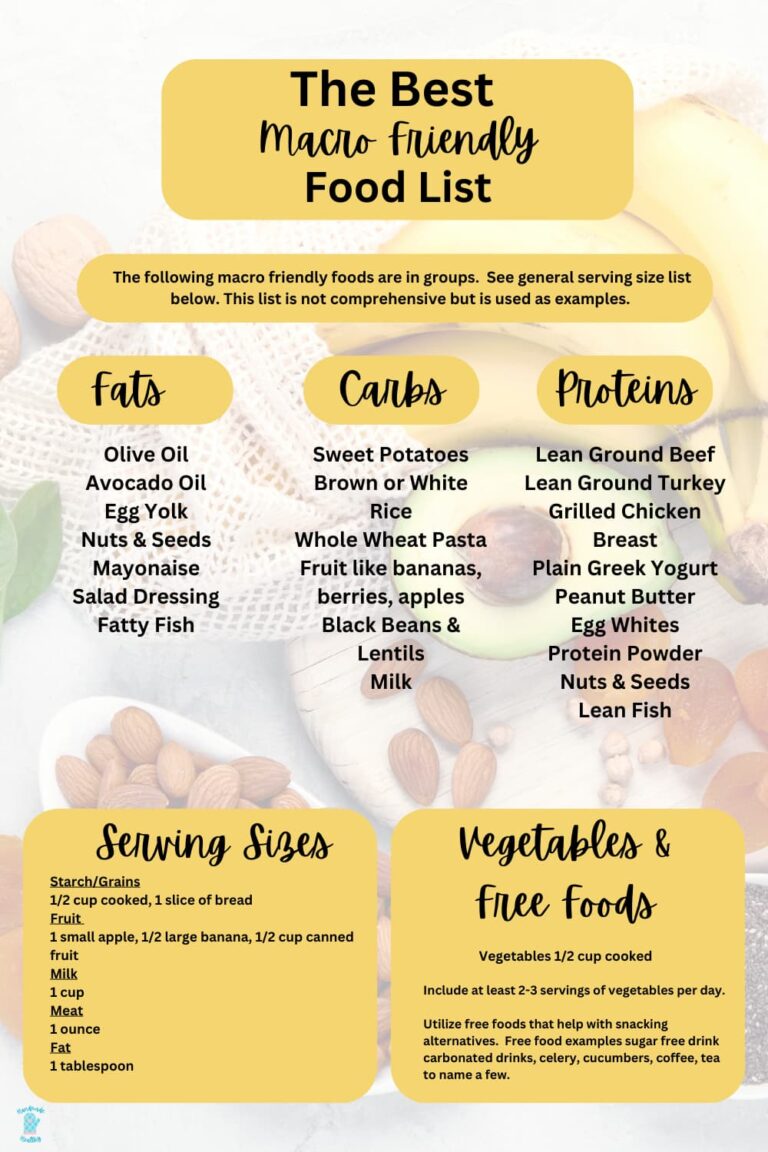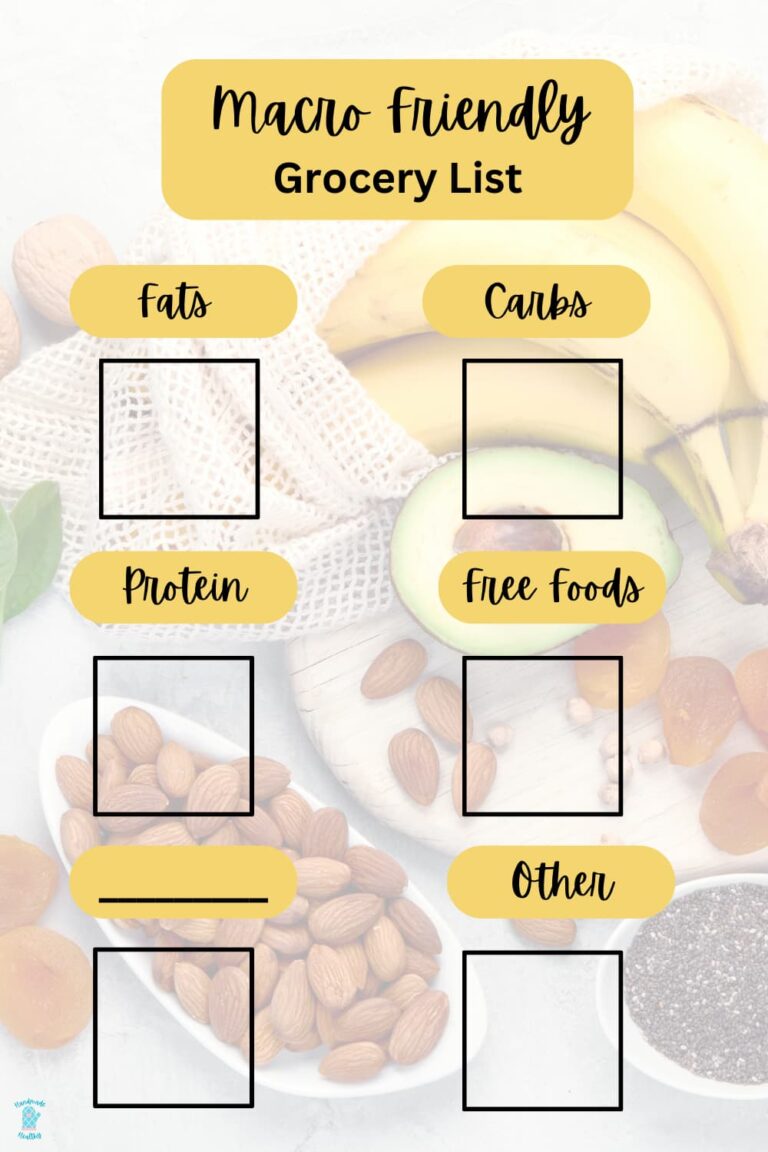When planning your fitness goals, you may be looking to set your macro goals. Using this macro friendly food list as a helpful tool, your grocery shopping planning will be a snap!
The information presented in this article is not meant for medical advice. It is general information to be used for informational purposes.
What Are Macronutrients?
The word macro is short for macronutrient. Macronutrients are foods that are generally eaten in larger amounts. Macronutrients include a variety of foods. They are classified into 3 main groups: fat, carbohydrate, and protein.
What is Macro Friendly Food
Macro friendly foods are foods that are included in the following groups: fat, carbohydrate, and protein. Macro friendly means that the food includes a dense macronutrient amount for its weight.
For example, a typical egg is a high protein food. Therefore, an egg is a macro friendly food due to the fact that is has a large amount of protein in a small volume.
How to Balance Macros & Macro Friendly Food List
Balancing macros is one of the hottest topics when it comes to weight maintenance, weight loss, and working out. Therefore, balancing macros depends on the goal of the individual.
If the individual’s goal is to maintain weight, they will want to have a balanced macro intake based on their caloric needs.
If a person wants to lose weight, their macro intake will likely be based on a caloric deficit to promote weight loss.
Additionally, if the individual’s goal is to build muscle mass when working out, their macro intake of carbohydrates and lean protein may be increased.
Acceptable Macronutrient Distribution Range
There is something called the Acceptable Macronutrient Distribution Range. Within this range is the balance of the macronutrient amounts.
Here are the ranges:
Carbohydrates range is 45 to 60% of calories from carbohydrates.
Fat range is 20 to 35% of calories from fat.
Protein range is 10 to 35% of calories from protein.
The range of the percentage depends on the desired outcome of the individual.
How Do We Use Macros and Macro Friendly Food List?
We can use macros to better understand how we are balancing our nutrition. Depending on health goals, macros are used to determine levels of nutrition in a healthy diet. Looking at the overall caloric intake, macros can be assigned different percentages of the total caloric intake.
List of Foods and Their Macros
In order to calculate macros it is helpful to have a simple and general list of macros in foods. Here are a few to get started.
- Starch/Grains 1/2 cup
- 15 g carbs, 3 g of protein, 0-1 g of fat
- Fruit 1/2 cup
- 15 g carbs, 0 protein, 0 fat
- Milk 1 cup
- 12 g carbs, 8 g protein, 0-8 g fat
- Meat 1 ounce
- 0 g carbs, 7 g protein, 0-8 g fat
- Fat 1 tablespoon
- 0 g carbs, 0 g protein, 5 g fat

Let’s talk about the components of food groups and their macros.
Fat
Fat is highest in energy, meaning calories. Fat is 9 calories per gram which is almost twice as much as carbohydrates and protein. Some examples of fat are butter, oil, and salad dressing.
Choose more fats that are lower in saturated fats (healthy fats) like olive oil versus lard which is higher in saturated fats.
In addition, there are also essential fatty acids that are needed as part of a balanced diet. There are also some micronutrient vitamins that require fat for absorption.
Carbohydrates
The carbohydrate group includes starch/grains, fruit, milk, other carbohydrates, and some vegetables. This food group of carbohydrates provides 4 calories per gram. Choosing complex carbs is preferable in order to increase the micronutrient and fiber content of the carbohydrates. Carbohydrates are important for energy levels, however, keeping portion sizes in mind is preferred.
Some examples of each subgroup are the following:
Starch/Grain example is pasta, bread, potatoes.
Fruit examples are a small apple, peach, pear, and bananas.
Milk examples are milk, yogurt, cottage cheese. The calorie content of these milk group foods depends also on the fat content as well. The fat content varies from non-fat up to whole fat.
Other carbohydrates examples include added sugars.
Vegetables include cooked and raw vegetables. However, these are lower in calories than all other carbohydrates. For more a list of white carbohydrates see the white food list.
Proteins
Meat and Meat Substitute Group
The meat and meat substitute group includes meat which is 4 calories per gram. Like milk, meat ranges in fat content from very lean to high fat. Therefore the calories per serving are variable according to the amount of fat in it. Proteins are important to include due to the essential amino acids contained in them.
When choosing meat protein, look for lean meats for lower saturated fat content.
For inspiration on a protein forward snack board, check out these seafood charcuterie board ideas.
Tracking Macros for Weight Loss
When tracking macros, it is important to keep a good balance in mind. At times, when people are cutting down on one macro, it can be high in another macro. Therefore, keeping a balance in mind is a good way to look at the overall big picture of wellness.
In many weight loss diets, energy is reduced to less than expenditure. Typically, changing the proportion of macro friendly foods can be one way of tracking macros for weight loss. However, this all depends on the goals of the individual person.
Here are some examples of changing the proportion of macronutrients: Low Fat Diets, Low Carbohydrate Diets, and High Protein Diets. There are definitely pros and cons to each so that is why a goal of balance is important.
Macro Meals for Beginners
Using the macro friendly food list, you can create really fun meals that aren’t boring, keep you more satisfied, and create a balance for your personal goals.
Using the groups of fats, carbohydrates, and protein, you can build out your macro meals.
Most people think of the grains for carbohydrates, the meat for protein, and an oil or dressing for the fats; however, don’t forget about the benefits of fruits and vegetables.
Fruits and vegetables have fiber and micronutrients that can help round out a meal and also create a sense of satiety from the meal.
Portion sizes are also a key to creating macro meals.
Macro Friendly Food List Recipes
One of the easiest and macro friendly cooking methods for recipes is to use an air fryer.
Here are some examples of macro friendly food recipes.
This chicken taco casserole recipe has 10 grams of fat, 27 grams of carbs, and 35 grams of protein. The recipe per serving is 337 calories. Therefore, 26% calories from fat, 32% calories from carbohydrate, and 41% calories from protein.
This beef and cabbage stir fry recipe has 18 grams of fat, 30 grams of carbs, and 33 grams of protein. The recipe per serving is 414 calories. Therefore, 39% calories from fat, 29% calories from carbohydrates, and 32% calories from protein.
–Ground Turkey Sweet Potato Skillet
This ground turkey sweet potato skillet recipe has 13 grams of fat, 45 grams of carbs, and 33 grams of protein. The recipe per serving is 418 calories. Therefore, 27% calories from fat, 43% calories from carbohydrates, and 31% calories from protein.
Free Foods When Counting Macros
There are some foods that don’t have enough macros in it to really count toward or against your macro count. These are foods like vegetables that contain a lot of water and or fiber content such as cucumbers and celery.
In addition, there are also some items such as sugar free gelatin that can also be considered a free food because it has a low carbohydrate and low calorie content, low protein, and low fat. Additionally, cauliflower rice is considered a free food vegetable.
Here are some additional examples of free foods:
- Broth without fat
- Sugar Free Beverages
- Coffee and Tea plain or no added sugar
- Raw Vegetables such as cucumbers and salad greens
- Sugar Free Gum
- Dill Pickles
Ultimate Macro Friendly Grocery List Worksheet
Having a macro grocery list to guide you through your shopping is a useful tool.

Macro Friendly Food List for Meal Prep
When you head to the grocery store, don’t forget your macro-friendly grocery list for your meal planning.
Fats: (9 calories per g fat)
- Olive Oil
- Avocado Oil (Avocados)
- Egg Yolk
- Nuts/Seeds (they count in both protein and fats)
- Mayonnaise
- Fatty Fish (they also count in both protein and fats)
Carbohydrates: (4 calories per g carbs)
- Sweet Potatoes
- Brown Rice (or White Rice)
- Whole Wheat Pasta
- Fruit like bananas, berries, apples
- Black Beans and Lentils (counts as both carbohydrates and proteins)
Proteins: (4 calories per g protein)
Ideally, lean proteins are great for macro friendly proteins. Lean proteins have less saturated fats than high fat proteins. However, a variety of proteins can be part of your daily protein goal.
- Lean Ground Beef
- Lean Ground Turkey
- Grilled Chicken Breast
- Plain Greek Yogurt
- Peanut Butter
- Egg Whites
- Protein Powder
- Nuts/Seeds
- Lean Fish
Sticking with Your Macro Goals
Set your goals for the month, and stick with your goals. Moreover, you may want to do some things to help motivate you to achieve your goals.
Here are a few ways to stick with your macro goals:
1. It may sound silly but place your goal chart on the refrigerator as a daily reminder to keep track of your macros.
2. In addition, being a part of an accountability group is a great way to not only motivate yourself but also cheer on others as well. You can find groups in your community or online.
3. Reward yourself with non-food rewards such as getting your nails done or getting a massage.
Determine Your Macro Ratios
Calculate your macro ratios using a macro calculator. However, keep in mind that this is just an estimate. If you want to have an accurate count, refer to a health care professional for guidance.

How to Eat Macro Friendly Foods at a Fast Food Restaurant
You are wondering what to do when it comes to fast food restaurants and macros. One of the best practices is to check the menu before you arrive so that you have time to make a decision.
Often times, in a fast food line, we feel rushed to make a quick decision. Here are some examples of common items that are better choices than deep fried options and less nutrient rich options.
- grilled options
- meat without breading options
- side salad with dressing
- yogurt cups
- baked potato
- breakfast eggs
- fruit cup
- smoothies with protein and no added sugar
- Add: veggie add-ons, fruit choice options, milk
Helpful tips for building a balanced plate can be found on My Plate.
If you enjoyed learning more about macro friendly food list, you may also like vibrational frequency of food list.
If you enjoyed this article insight, you may also like Clean Eating Food List Printable.



















